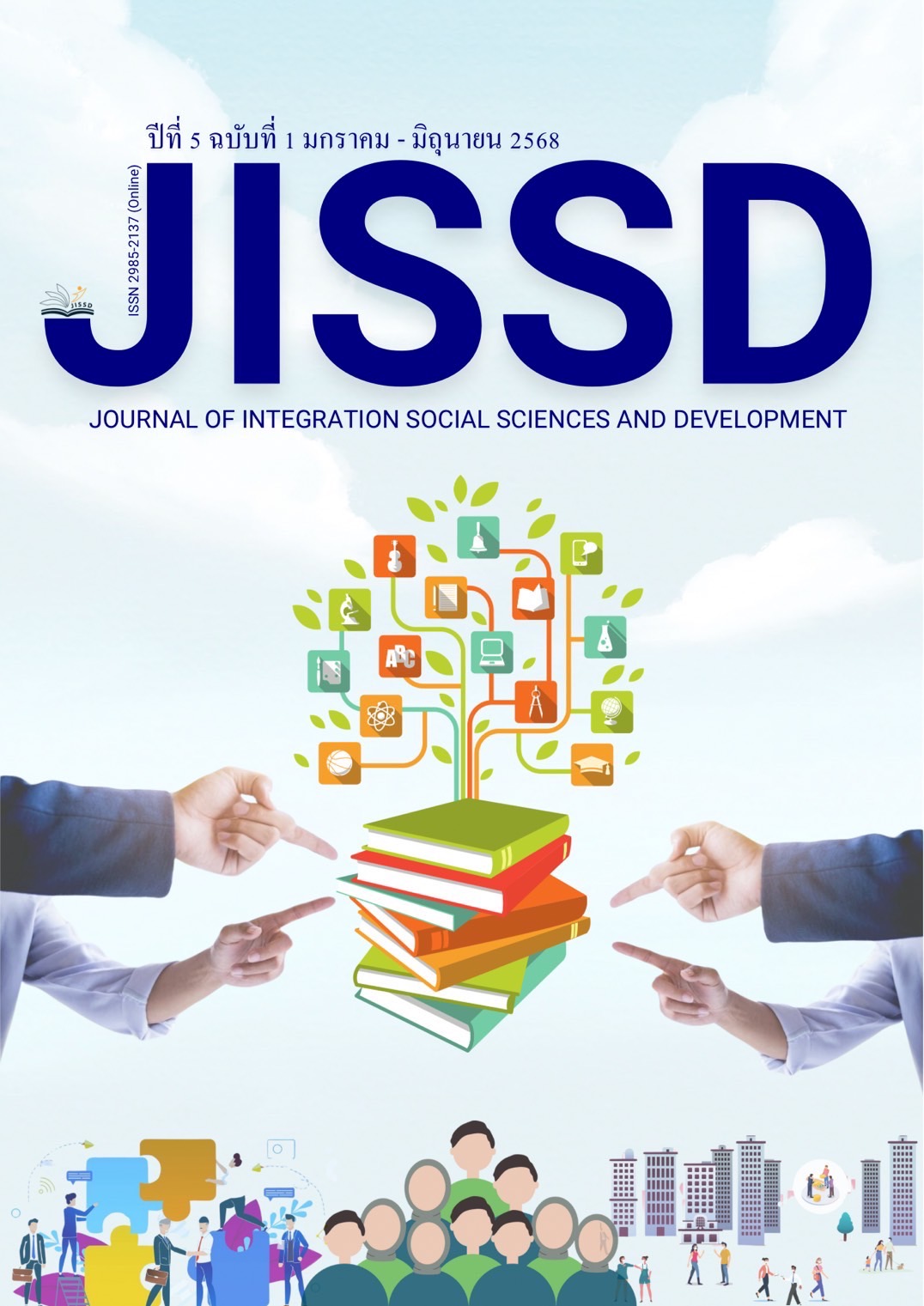Innovative Leadership of School Administrators Affecting the Learning Organization of Schools under the Saimai District, Bangkok
Main Article Content
Abstract
The objectives of this research were to study: 1) Study the innovative leadership of school administrators. 2) Study the learning organization characteristics of the school. 3) Study the relationship between innovative leadership of school administrators and the learning organization of the school. 4) Examine how the innovative leadership of school administrators influences the learning organization of schools under the Saima District, Bangkok. The sample consisted of school administrators and teachers, with the sample size determined using Krejcie and Morgan's table, resulting in 240 participants selected through stratified random sampling. The research instrument was a 5-point rating scale questionnaire with a reliability coefficient of 0.998. The statistics used for data analysis were frequency, percentage, mean, standard deviation, Pearson correlation, and multiple regression analysis. The research findings revealed: 1. The overall innovative leadership of educational institution administrators is at a high level. 2. The overall learning organization characteristics of educational institutions are at a high level. 3. The relationship between innovative leadership of educational institution administrators and the learning organization characteristics of educational institutions shows a positive correlation at a high level with statistical significance at the .01 level. 4. Innovative leadership of educational institution administrators, including creating an innovative atmosphere, building collaboration and teamwork, inspiring and encouraging participation, and monitoring and evaluating innovation, affects the learning organization characteristics of educational institutions with statistical significance at the .01 level. Together, these factors predict 71.80 percent of the variance in learning organization characteristics of educational institutions.
The prediction equations are as follows:
Raw Score Prediction Equation:
Ŷ = 1.23 + 0.162 X1 + 0.716 X2 + .253 X4 + 0.515 X6
Standardized Score Prediction Equation:
Z = 0.195 Z1 + 0.806 Z2 + 0.263 Z4 + 0.561 Z5
Article Details
References
กมลวรรณ แสนเสนาะ. (2567). ความเป็นองค์กรแห่งการเรียนรู้ของสถานศึกษาสังกัดสำนักงานเขตพื้นที่การศึกษามัธยมศึกษากรุงเทพมหานครเขต 1 กลุ่ม 2. วารสารสิรินธรปริทรรศน์, 25(2), 2293 – 2302.
กันตินันท์ เวชสาร. (2565). การพัฒนาชุดกิจกรรมการเรียนรู้โดยใช้แนวคิดเกมมิฟิเคชันเพื่อส่งเสริมทักษะคิดวิเคราะห์และผลสัมฤทธิ์ทางการเรียนเรื่องหน่วยพื้นฐานของสิ่งมีชีวิตสำหรับนักเรียนชั้นมัธยมศึกษาปีที่ 1. วิทยานิพนธ์ปริญญาครุ ศาสตรมหาบัณฑิต สาขาวิชาหลักสูตรและการสอน, มหาวิทยาลัยราชภัฏรำไพพรรณี.
เกียรติศักดิ์ วงษ์ชัย. (2567). ความสัมพันธ์ระหว่างภาวะผู้นำเชิงนวัตกรรมของผู้บริหารสถานศึกษา กับความเป็นองค์กรแห่งการเรียนรู้ของสถานศึกษา สังกัดสำนักงานเขตพื้นที่การศึกษาประถมศึกษาอุบลราชธานี เขต 5. วารสารวิชาการมหาวิทยาลัยราชภัฏศรีสะเกษ, 18(3), 27-83.
คณิศร ผู้มีทรัพย์. (2562).ความสัมพันธ์ระหว่างภาวะผู้นำเชิงนวัตกรรมของผู้บริหารสถานศึกษา และความเป็นองค์กรแห่งการเรียนรู้ของสถานศึกษา สังกัดสำนักงานเขตพื้นที่การศึกษามัธยมศึกษา เขต 14 จังหวัดภูเก็ต. ศึกษาศาสตรมหาบัณฑิต.สาขาบริหารการศึกษา.มหาวิทยาลัยสุโขทัยธรรมาธิราช.
ปารวี บุญเพชร์, เก็จกนก เอื้อวงศ์ และชูชาติ พ่วงสมจิตร์. (2563). ความสัมพันธ์ระหว่างภาวะผู้นำเชิงนวัตกรรมของผู้บริหาร สถานศึกษากับความเป็นองค์กรแห่งการเรียนรู้ของสถานศึกษาในสังกัด สำนักงานเขตพื้นที่การศึกษาประถมศึกษานครศรีธรรมราช.วารสารศึกษาศาสตร์ มสธ. 14(1), 29-44.
พิมพ์พิไล เหล่าพิมพ์. (2565). ปัจจัยภาวะผู้นำเชิงนวัตกรรมที่ส่งผลต่อองค์กรแห่งการเรียนรู้ของสถานศึกษาสังกัดสำนักงานเขตพื้นที่การศึกษาประถมศึกษาในจังหวัดอุดรธานี. วารสาร มจร อุบลปริทรรศน์, 7(2), 2197-2210.
ภูมิประสิทธิ์ ไชยบาล. (2566). ความสัมพันธ์ระหว่างภาวะผู้นำเชิงนวัตกรรมกับความเป็นองค์กร แห่งการเรียนรู้ในสถานศึกษา สังกัดสำนักงานเขตพื้นที่การศึกษาประถมศึกษาพะเยา เขต 2. มหาวิทยาลัยพะเยา
ส่วนนโยบายและแผนการศึกษา สำนักงานยุทธศาสตร์การศึกษา สำนักการศึกษา กรุงเทพมหานคร. (2563). แผนพัฒนาการศึกษาขั้นพื้นฐานกรุงเทพมหานคร ฉบับที่ 3 (พ.ศ. 2564- 2569). กรุงเทพฯ: วันไฟน์เดย์.
สำนักการศึกษา กรุงเทพมหานคร. (2567). รายงานสถิติการศึกษา ปีการศึกษา 2567 โรงเรียนสังกัดกรุงเทพมหานคร. กรุงเทพฯ: พจน์กล่องกระดาษ.
สำนักงานคณะกรรมการการศึกษาขั้นพื้นฐาน. (2562). รายงานผลการดำเนินงานประจำปี 2562. สำนักงานคณะกรรมการการศึกษาขั้นพื้นฐาน: กลุ่มวิจัยเชิงประเมินและสารสนเทศ สำนักติดตามและประเมินผลการจัดการศึกษาขั้นพื้นฐาน.
สำนักงานเลขาธิการสภาการศึกษา. (2560). แผนการศึกษาแห่งชาติ พ.ศ. 2560-2579. กรุงเทพฯ: พริกหวานกราฟฟิค.
อาริยา แสงนิล. (2567). ภาวะผู้นำเชิงนวัตกรรมของผู้บริหารสถานศึกษา สังกัดสำนักงานเขตพื้นที่การศึกษามัธยมศึกษาศรีสะเกษ ยโสธร. วารสารมหาจุฬาคชสาร, 15(1), 226 – 240.
Krejcie, R.V., & D.W. Morgan. (1970). “Determining Sample Size for Research Activities”. Educational and Psychological Measurement, 30(3). 607 – 610.
Tierney, P., Farmer, & Graen, G. B. (1999). An examination of leadership and employee creativity: The relevance of traits and relationships. Personnel psychology, 52(3), 591-620.
Van de Ven, A. H., & Chu, Y. (1998). A psychometric assessment of the Minnesota Innovation Survary. In A. Van de Ven, H. Angle, & M.S. Poole (eds.), Research on the Management of Innovation: The Minnesota Studies. New York, NY: Harper & Row.


